Strange creatures hide deep in the ocean floor
Deep in the deep ocean floor and harsh environmental conditions, there are still strange creatures that we cannot imagine. Join the adventurers to discover some scary animals on the seabed
Fishing rod
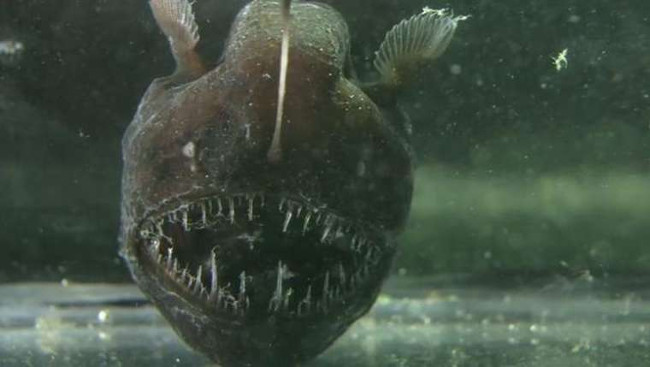 Strange creatures hide deep in the ocean floor Picture 1
Strange creatures hide deep in the ocean floor Picture 1
The fishing rod is brown or gray, 30 to 90 cm long. They live on the bottom of the Arctic Ocean and the South Ocean. This fish has a scary look with big head, wide mouth, sharp teeth.
The name of the fishing rod comes from the back of the spine that juttes forward to the mouth that looks like a glowing fishing rod to attract prey.
Nautilus
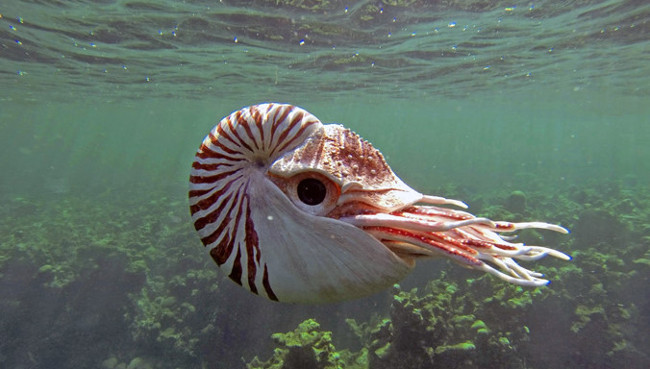 Strange creatures hide deep in the ocean floor Picture 2
Strange creatures hide deep in the ocean floor Picture 2
Conch shells live in the seabed a few hundred meters deep in tropical and subtropical regions. Vu's snail belongs to the class of head-legged animal like squid and octopus.
During the day, the British snail lives at 600 m below sea level but at night they move to the shallower waters to search for prey. The snail's eyes are very weak because there is no lens. Their brown-and-white striped shells are divided into many body chambers and 90 tentacles. The adult snail contains gas in 30 inner compartments to float and store liquid in some compartments for swimming.
Ink
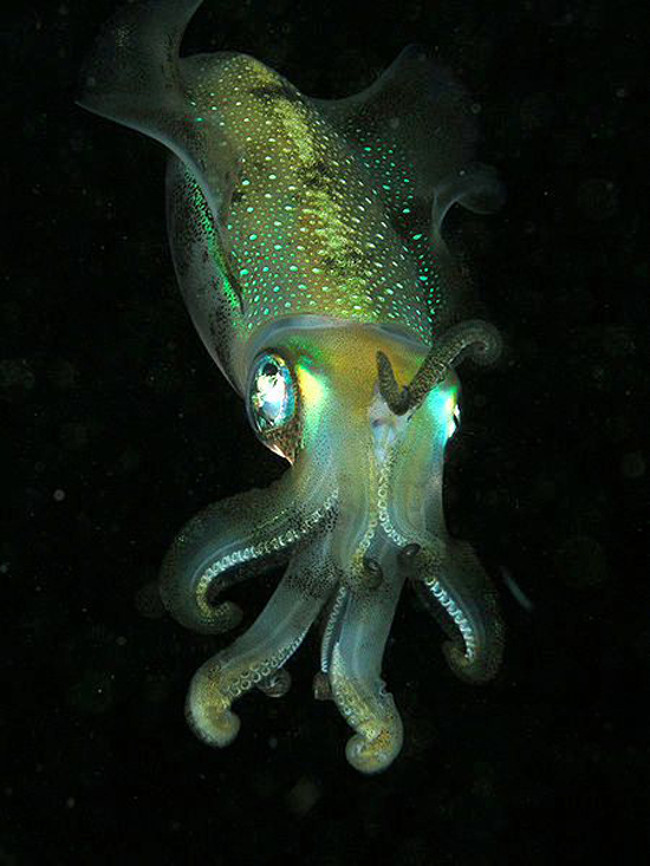 Strange creatures hide deep in the ocean floor Picture 3
Strange creatures hide deep in the ocean floor Picture 3
Many squid species live in dark seabeds like vampire ink, giant squid, big fin squid (Magnapinna).
Giant squid is large in size with females longer than 13 m and males longer than 10 m while other squid species like vampire ink are only 30 cm long.
In 2007, a large squid like aliens were recorded at 2,377 m in the Gulf of Mexico.
Fish fangs
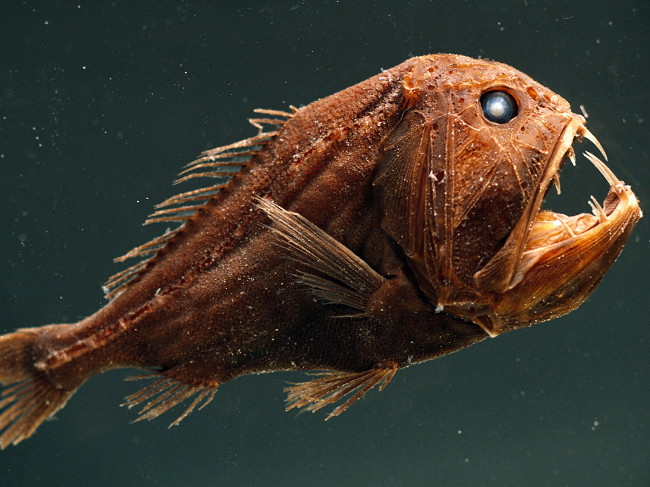 Strange creatures hide deep in the ocean floor Picture 4
Strange creatures hide deep in the ocean floor Picture 4
Fish fangs live at 4,877 m in tropical and temperate seas around the world. They have a ferocious appearance so they are also called goblin fish. This fish is very small, not more than 17cm long. Fish fangs do not lie in prey but actively use their wide mouth and teeth to trap and find food.
Cookiecutter sharks
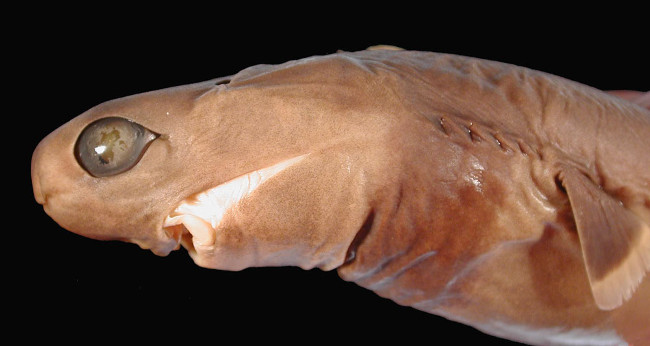 Strange creatures hide deep in the ocean floor Picture 5
Strange creatures hide deep in the ocean floor Picture 5
Possessing scary teeth, this shark is called Cookiecutter. They are parasites, not predators. Cookiecutter sharks are only 48 cm long, they use their strong teeth to bite into the host tightly and twist and twist their bodies until they cut a piece of meat. Cookiecutter's name was born because of this frightening way of eating.
This species of grouper lives in warm, equatorial waters, at depths of more than 300 m.
Snake fish Viper
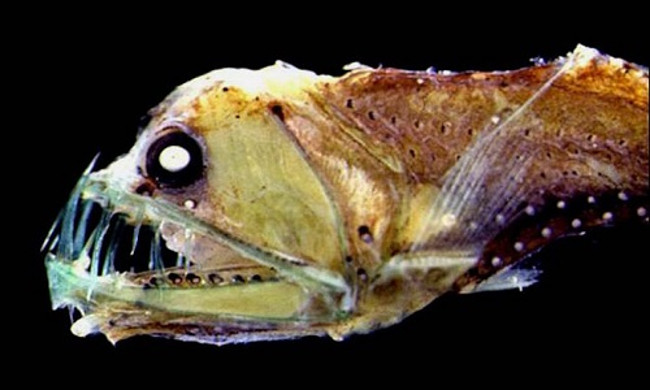 Strange creatures hide deep in the ocean floor Picture 6
Strange creatures hide deep in the ocean floor Picture 6
The snake Viper has the scientific name Mesopelagic, living at a depth of 1,524 m with a wide mouth, large lower jaw and teeth like fangs. This is one of the most ferocious seeming animals of the ocean.
Some individuals of this species can glow to attract prey, otherwise they will chase their prey. They use their teeth to pierce their prey if they are too big.
Sharks are ranked
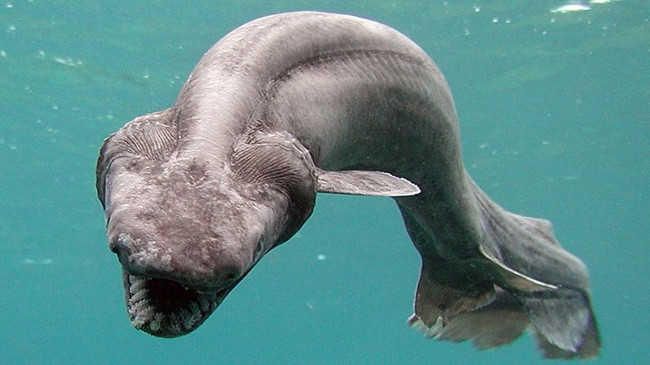 Strange creatures hide deep in the ocean floor Picture 7
Strange creatures hide deep in the ocean floor Picture 7
The shark shark has been classified as an undersea fossil because it has remained virtually unchanged for 80,000 years and still retains the characteristics of sharks during the dinosaurs. Strange sharks are rare because they live in the deep sea about 1,219 m.
This fish has an eel-like body, and adults can reach up to 2m long. They own 25 teeth with a total of 300 teeth.
Lantern fish
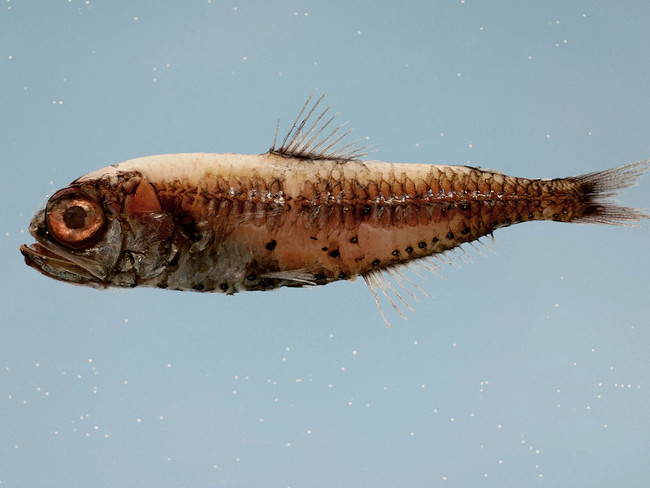 Strange creatures hide deep in the ocean floor Picture 8
Strange creatures hide deep in the ocean floor Picture 8
Lantern fish are very diverse in types. They have at least 240 types, distinguished by small organs on the head, tail and abdomen.
This species is quite small, only 2.5 - 15 cm long and lives at a depth of 305 m below the water surface. Distributed throughout the world, lantern fish plays an important role in the food chain as bait for squid and penguins.
Giant spider crab
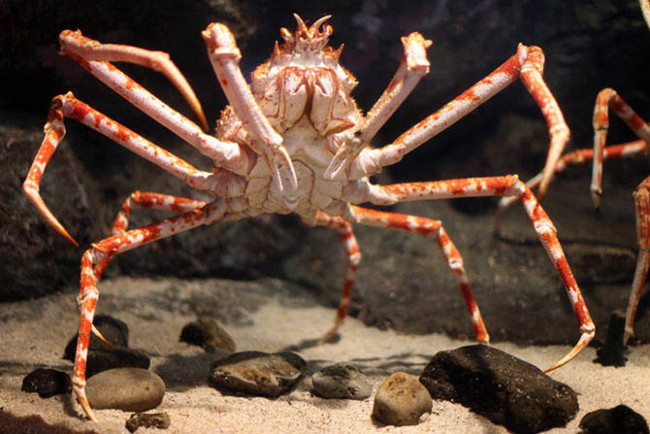 Strange creatures hide deep in the ocean floor Picture 9
Strange creatures hide deep in the ocean floor Picture 9
This species has a foot length of 3.6 m, a body width of 41 cm and a weight of 18 kg. This is the largest crab in the world.
This crab can only be found in Suruga Bay, Japan, so it is also called Japanese spider crab. They live at a depth of 152 - 305 m, can live up to 100 years and eat everything. However, they are primers for larger species such as squid. For self-defense, they often camouflage with sponges.
Atlantic wolves
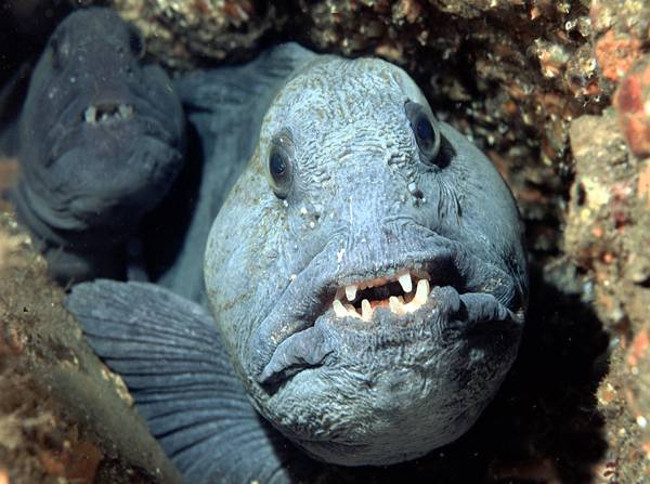 Strange creatures hide deep in the ocean floor Picture 10
Strange creatures hide deep in the ocean floor Picture 10
This species has been dubbed the ocean monster because of its frightening, bizarre shapes. With eel-like bodies, large teeth, big heads, strong jaws, they can eat hard-shelled animals like sea urchins, crabs or snails.
This fish lives in cold waters north of the Atlantic Ocean at a depth of 457m. Mature Atlantic wolves are 1, 5 meters long and weigh 18 kg, are blue, violet brown or olive green.
Six sharks carry a prison nose
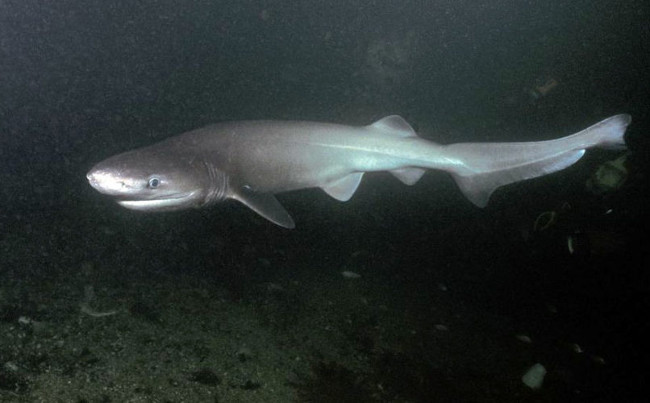 Strange creatures hide deep in the ocean floor Picture 11
Strange creatures hide deep in the ocean floor Picture 11
Six-bearing sharks have large bodies, big heads and glowing blue eyes.
They can be 4.5 - 4.9 m long and weigh nearly 600 kg and are one of the largest shark species in the world.
This species lives at a depth of nearly 2,000 m and moves to the shallower waters to hunt. They are gray, gray-brown or black in the back and lighter colors in the lower abdomen. Photo: Washington Department of Fish and Wildlife.
Giant tubeworm
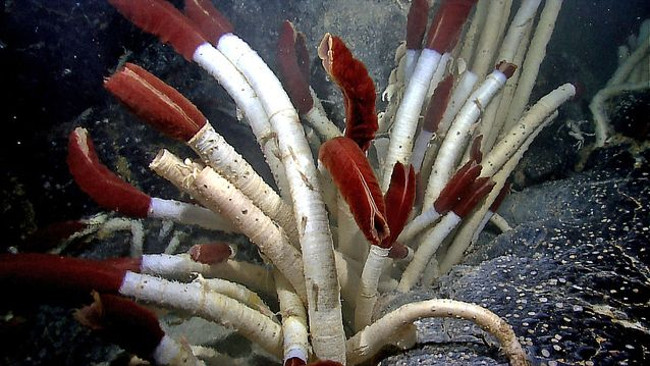 Strange creatures hide deep in the ocean floor Picture 12
Strange creatures hide deep in the ocean floor Picture 12
Giant pipe worms are found at the bottom of the Pacific Ocean, where the most extreme conditions are found: around the hydrothermal mouth, cracks in the sea floor spray hot water containing acids and toxic gases.
They are up to 2.4 meters tall and 4 meters in length. Giant ductworm is the most developed species in the invertebrate class, they grow to 33 cm per year. This means they have a very long life. The tip of the tube is full of blood so it is bright red.
Paddle fish
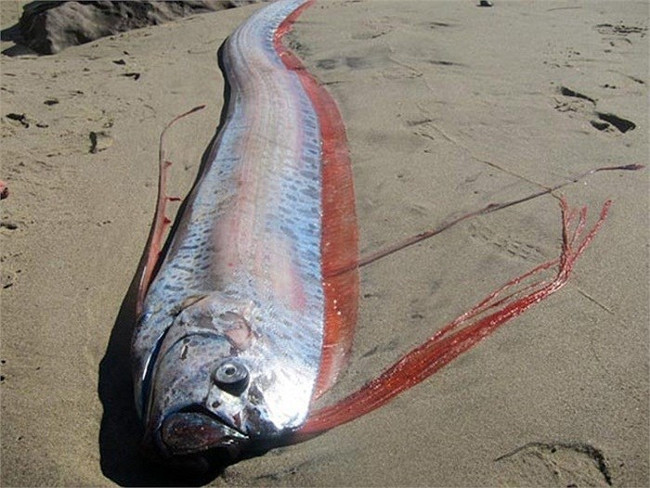 Strange creatures hide deep in the ocean floor Picture 13
Strange creatures hide deep in the ocean floor Picture 13
The world's largest bony fish can reach 17 meters long and weighs 272kg. They are rare animals because they live at a depth of 914 m. Distributed in waters all over the world, the oars are lumpy, covered with guanine. On the surface of the water, their skin is soft and vulnerable.
Lobster squatting
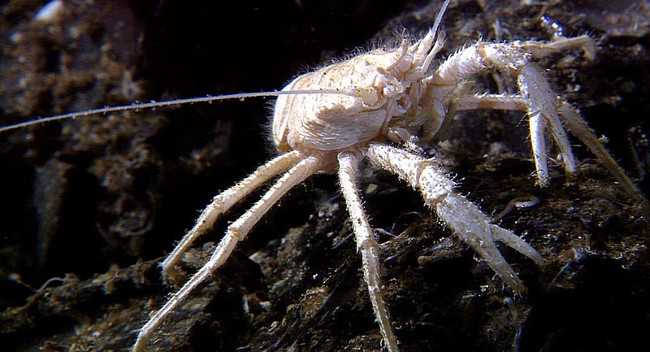 Strange creatures hide deep in the ocean floor Picture 14
Strange creatures hide deep in the ocean floor Picture 14
Squatting lobster lives at 1,402 m depth on the seabed and distributed all over the world. They are often blind and have a soft body. Lobster squatting does not carry shells on the back. Instead, they fled into the gap, usually coral reefs. The squat lobster body is covered with small hair that is only a few centimeters long. They have relatives closer to crabs than other lobsters.
Because its legs curled under the chest, like the squatting posture, this lobster is named so.
Jellyfish
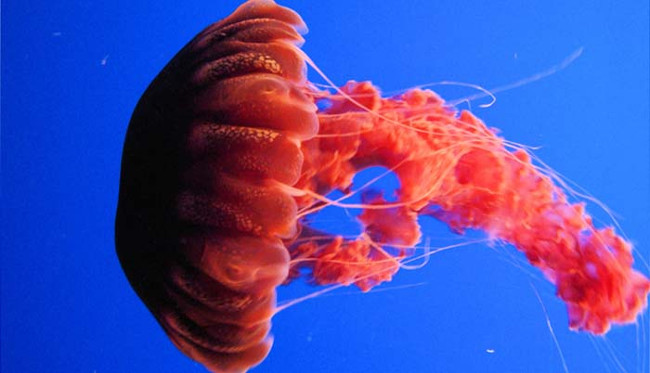 Strange creatures hide deep in the ocean floor Picture 15
Strange creatures hide deep in the ocean floor Picture 15
Many jellyfish live in the deep sea like crown jellyfish, Atolla jellyfish and jellyfish Narcomedusae. Despite their vivid colors, they are almost invisible in the deep dark waters. Jellyfish live throughout the world's oceans from cold to warm seas. Their bodies contain 95% water and no brain. Photo: Flickr.
You should read it
- Sharks plunge into gobbling up giant fish thousands
- Assassin sharks ripped huge squid in death
- 20 animals are so strange that you don't believe they exist on Earth (part 1)
- The strange creature re-grows its head, turning its prey into water
- Catching a strange long-body shark like a snake, possessing up to 300 teeth and dating back to prehistoric times
- Why do whales swing their tails up and down, but sharks swing their tails to the sides?
- Listed 10 largest species of creatures in the ocean
- 15 most giant animals in the natural world
- Scientists discover what's left of the oldest Antarctic creature
- Whether alive or extinct, these giant creatures will make you feel tiny
- Marvel at bizarre fish in the ocean
- Hybrid between giant spiders and scorpions, this furry exotic creature is the fear of many people
May be interested

Hurricane No. 3 is approaching level 14 in Vietnam

Marvel at animals with superhuman abilities that look exactly like Pokemon

Startling the monstrous creatures with faces from ... hell

The reason why hummingbirds never had an accident

Concussion: Discovering ancient seas off the Philippines

The most exotic snail in the world makes the US military study






 10 strange creatures found in the deep sea in 2021
10 strange creatures found in the deep sea in 2021 The most bizarre creatures are found by scientists under the sea floor of Australia
The most bizarre creatures are found by scientists under the sea floor of Australia Catching a strange long-body shark like a snake, possessing up to 300 teeth and dating back to prehistoric times
Catching a strange long-body shark like a snake, possessing up to 300 teeth and dating back to prehistoric times 10 photos showing how small people are in the ocean
10 photos showing how small people are in the ocean Robot fish helps us experience the close-up of the ocean world
Robot fish helps us experience the close-up of the ocean world Discover 5 strange creatures than even science fiction novels
Discover 5 strange creatures than even science fiction novels